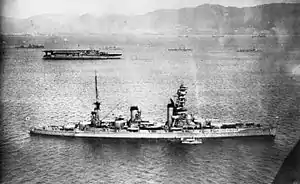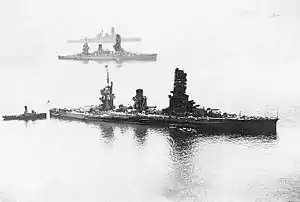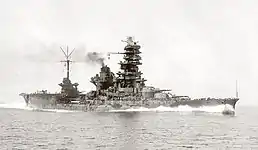Pagoda mast
The pagoda mast was a type of superstructure that was common on Japanese capital ships that were reconstructed during the 1930s in a bid to improve their fighting performance. These modifications were deemed to be necessary by the Imperial Japanese Navy as a result of the "Battleships Holiday" that was imposed by the Washington Naval Treaty, which strictly limited the construction of new battleships.[1]

Development
Pagoda masts were built on existing tripod masts by adding searchlight and other platforms, lookouts and shelters upon each other, the end result resembling a pagoda temple. The superstructures were constructed on the majority of the ships that were rebuilt by the Japanese, including the Kongō-class battlecruisers and the Fusō, Ise, and Nagato-class battleships. The additional platforms were supported on the ships' original tripod foremasts (a design also extensively used by the Royal Navy) and these were suitably strengthened to bear the extra weight they had to carry. Some of the pagoda masts that were built on Japanese warships during the 1930s were indeed very large. For instance, the top of the pagoda mast of the Imperial Japanese battleship Fusō was 40 m (130 ft) above the waterline.


Like the British Royal Navy, which was considered to be a likely enemy of Japan in the event of an armed conflict, the Imperial Japanese Navy wanted to prepare their warships for engaging in combat at night. Prior to the outbreak of World War II, powerful searchlights were placed on the pagoda masts for the purpose of illuminating enemy ships at night. However, during the early 1940s, the searchlights mounted on the pagoda became less important as new radar technology was developed that allowed a ship to aim and shoot at targets at night.[2][3]
In the navies of Europe and the Americas, tall pagoda-style masts were generally frowned upon. Naval architects and sailors from the Western hemisphere claimed that the Japanese battleships were too "top-heavy" and critics often mocked these vessels by nicknaming them "Christmas Trees". Uniquely the battleship Hiei received a prototype of the pagoda-style tower-mast that would eventually be used on the upcoming Yamato-class battleships, then still in the design phase, rather than the pagoda masts used on her sister ships and other modernized World War I-era capital ships.[4]
During the same interwar period, the Royal Navy implemented the "Queen Anne's Mansions" style conning tower and bridge, either retrofitted World War I-era battleships (three of the Queen Elizabeth class, HMS Renown) or for new battleships (Nelson and King George V classes). Between World War I and World War II, the US Navy would gradually phase out the cage masts on its Standard type battleships in favor of tripod masts, and after Pearl Harbor some of the salvaged battleships were reconstructed with conning towers similar to those on its post-treaty battleships.
Gallery
Japanese battleship Ise, showing the development of her pagoda mast over time.
 Japanese battleship Ise in 1917–1918, shortly after completion
Japanese battleship Ise in 1917–1918, shortly after completion Ise, unknown date, with tripod mast
Ise, unknown date, with tripod mast Ise, after reconstruction
Ise, after reconstruction Higher resolution image c. 1943
Higher resolution image c. 1943
References
- "CONFERENCE ON THE LIMITATION OF ARMAMENT, 1922". www.ibiblio.org. Retrieved 2017-05-31.
- "Japanese Radar Equipment in WWII". www.combinedfleet.com. Retrieved 2017-05-31.
- Nakajima, S.; "Japanese radar development prior to 1945," IEEE Antennas and Propagation Magazine, vol. 34, Dec., 1992, pp. 17-22
- "Imperial Japanese Navy Mysteries".
